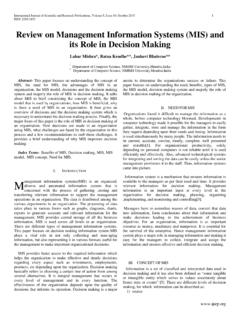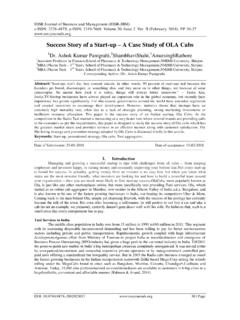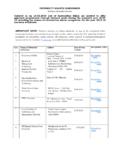Transcription of Near Miss Incident Management, the Root for an Effective ...
1 International Journal of Scientific and Research Publications, Volume 5, Issue 10, October 2015 1. ISSN 2250-3153. Near miss Incident management , the root for an Effective Workplace Safety is determined by the management Commitment Isaac M. Mbuvi , Professor Robert Kinyua, Dr. Fred Mugambi Jomo Kenyatta University of Agriculture and Technology Mombasa Campus, Box 81310-80100 Mombasa Abstract- Near miss incidences are often ignored by most property damage (Vassiliou , 2009). Thus, many stakeholders in the workplace and yet every major or fatal opportunities to prevent the accidents that the organizations have accident or Incident originates from a near miss that was not not yet had are lost. Near misses are often less obvious than prevented or controlled.
2 management of near miss incidences is accidents and are defined as having little if any immediate impact directly proportional to the prevention of major incidences and on individuals or processes. Despite their limited impact, near accidents and therefore goes a long way to eliminate or minimize misses provide insight into potential accidents that could happen. work place hazards and guarantee the safety of the workers with Safety activities in most organizations are reactive and not a direct bearing on the overall performance of the organization. proactive. Many organizations wait for losses to occur before Although the near- miss concept has long been understood in the taking steps to prevent an occurrence. oil industry, what has been largely missing is the integration of near- miss management into the safety culture and day to day Overview of Near miss operations in a manner that underlines the critical connections A near miss is an unplanned event that did not result in between near-misses and behavior.
3 In the oil industry, Incident injury, illness, or damage but had the potential to do so. Only a assessment is key to its very survival and profitability. But fortunate break in the chain of events prevented an injury, fatality among other incidences, there were challenges in the or damage; in other words, a miss that was nonetheless very near. management of the near miss incidences in the organization, A near miss is also any unplanned event or chain of events in hence the necessity of the study to determine the role of near which personal injury or damage to property, plant or equipment miss incidents management on the safety performance of the has only been avoided by choice or chance. organization. Near miss Incident management System theorems A broader definition which focuses not only on the negative were also part of this study.
4 In this study the target population side of near misses but also on their positive contribution to a was the workers in an Oil and Gas organization . This involved system's operation describes a near miss as an event, a sequence those engaged in storage of white (refined) oil products, pipeline of events, or an observation of unusual occurrence that possess transportation and dispensing of petroleum products within the the potential of improving a system's operability by reducing the study area. For this descriptive study, a random sampling was risk of upsets some of which could eventually cause serious used to select a representative sample of the target population. damage. A near miss is an opportunity to improve Data collection in the research was through the use of structured environmental, health and safety practice based on a condition, questionnaires designed by the researcher.
5 Questionnaires were or an Incident with potential for more serious consequence. Near distributed in cluster and randomly among the workers. After miss is viewed as improvement opportunities which positive data collection, analysis of the same was done using appropriate experiences are encouraging employees to report rather than to statistics software such as SPSS. The study found that hide. It also includes all operational disturbances, some of which management commitment in the organization may be improved have the potential to cause serious damage while others are by the availing of resources for the establishment, inconveniences that mainly cause inefficiencies. It not only implementation and maintenance of a Near miss Incident captures events but also includes observation.
6 management System (NMIMS) for an Effective work place Although the label of 'human error' is commonly applied to safety performance an initiating event, a faulty process or system invariably permits or compounds the harm, and should be the focus of Index Terms- Near miss , Incident , Hazard improvement. Other familiar terms for these events are a "close call", or in the case of moving objects, "near collision" or a near hit. According to (Lauver et al 2009) a near miss is defined as I. INTRODUCTION anytime an employee felt that they were in an unsafe situation due to circumstances, equipment, or their own actions which had A t the root of every accident or Incident fatal or otherwise is a near miss that was ignored and not prevented. Near miss incidents often precede loss producing events but are largely a high probability of resulting in an injury, and only by good fortune did the employee remain uninjured.
7 Near miss ignored because nothing (no injury, damage or loss) happened. definitions vary and may even include incidents that result in Employees may not be enlightened to report these close calls as damage or injuries but not death. there has been no disruption or loss in the form of injuries or International Journal of Scientific and Research Publications, Volume 5, Issue 10, October 2015 2. ISSN 2250-3153. Statement of the problem As numerous catastrophes illustrate, management failure to capture and remedy near-misses may foreshadow disaster. Notable examples where near- miss precursors have been observed but not effectively managed with dire consequences include:- The 1997 Hindustan refinery explosion in India. Sixty people died and over 10,000 metric tons of petroleum-based products were released to the atmosphere or burned.
8 Written complaints of corroded and leaking transfer lines where the explosion originated went unheeded (Khan and Abbasi, 1999).the 1998 morton explosion and fire resulting from a reactor temperature excursion (khan et al, 1999).nine people were injured, two seriously In an accident investigation, the The Safety Pyramid Chemical Safety Board concluded, management did not investigate evidence in numerous completed batch sheets and Essentially, injury data capture the unfortunate individuals. temperature charts of high temperature. As these examples To illustrate this, Lauver et al. cited Heinrich's (1931) finding illustrate, failure to utilize precursor data to identify and remedy that for every 300 unsafe acts, 29 minor injuries occur and one systemic flaws can have catastrophic results.
9 To reduce the major injury occurs (Lauver et al., 2009). likelihood of future catastrophe and further improve employee safety and process reliability, management systems that The Ice Berg Theory recognize operational weaknesses need to be developed to seek According to this theory, workplace incidents and accidents and utilize accident precursors (March et al., 1991). These cost an organization in terms of compensation payments but programs operate under the umbrella of Near miss management more costs are the indirect costs of the same. It is a calculation Systems. Near miss management systems have been developed method developed to estimate the indirect costs of an Incident or and are implemented across a range of industries including the accident in the workplace.
10 Assuming the cost of an accident is chemical/process, airline and rail, nuclear and medical shillings 10, costs which include but not limited disciplines. to investigations, loss in productivity, equipment downtime is five times the accident cost which will be shillings 50,000 . The replacement costs such as overtime, new employee, re-training II. RELATED LITERATURE will be shillings 10,000. The real cost of this accident shall be The Safety Pyramid shillings 70,000 which is seven times the cost of the accident. Unsafe act or mechanical or physical hazard lines up with Therefore in the Iceberg Theory, the initial cost of an accident is Heinrich's third, and arguably most controversial, axiom: The only the tip of what it really costs an organization. unsafe acts of persons are responsible for the majority of accidents.

















